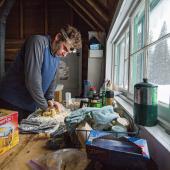The Fungus Among Us
The slopes of the Mill Creek drainage, near the Absaroka-Beartooth Wilderness boundary, look bleak and dark. Blackened torsos of burned trees contrast the clear blue sky. Gushing water rips deep cuts in the soft, fire-damaged ground. Many trees have been forcefully uprooted by high winds, leaving gaping holes in the charred earth.
Mushrooms are the first to re-inhabit this barren landscape, providing a paradise for mushroom hunters. Morels are among the tastiest to pop up, and they are some of the most resilient organisms here. They love this disturbed, imbalanced environment created by the fires.
Is Mill Creek the gold mine for morels this spring? Who knows—the mushrooms have a mind of their own. In the past, some promising locations were devoid of mushrooms. Other locations close to major towns turned out to be plentiful and blissfully absent of other mushroom pickers.
Regardless, the fickleness of these mushrooms is no deterrent to hungry mushroom lovers. They come from all over the United States not only to enjoy the beauty of this spectacular drainage, but to buy those precious gourmet mushrooms and resell them in large cities where they are considered delicacies. They are indeed a hot commodity (an ounce of dried morels—about six mushrooms—cost $16.79 at one online mushroom retailer when this article went to print), but the mushroom wars have not hit Montana as they have hit the West Coast. I have heard about a Russian mushroom mafia in California and Asian mushroom gangs in Oregon! Nonetheless, with more and more people moving to Montana, the confrontations over morel claims will grow.
If you decide to go hunting for mushrooms, don’t forget to bring a sharp knife and a breathable bag (mushroom pickers in Europe once used willow baskets). Ask permission before picking mushrooms on private land, and beware that if you pick mushrooms in a national park, you have to eat them there. Mushrooms on river shores under high water mark are on public property.
Morel mushrooms are easy to identify. Unlike most mushrooms, they have a honeycomb conical cap with a short, hollow stalk. In Montana they come in black, tan, and yellow colors. But be wary of false morels! Some contain a toxin that is used in rocket fuel. Never eat a mushroom you are not sure about.
Once you have your mushrooms safely home you can keep them in a refrigerator, dry them, or eat them fresh. For storage or a unique gourmet gift, you can dry them on a string.
Morel Mushroom Hash
During the spring, I usually find a few morels along the Gallatin River. Not being greedy, I pick enough for a sauce or to sauté for dinner. Always remember that if you don’t know what kind of mushroom it is, refer to a guidebook. There are many available, and it will make your treks in the hills that much more enjoyable.
Here is a simple way to prepare and use morels. It is a good side to beef, pork, or fish.
Take:
1 medium yellow onion (diced)
1 pound morel mushrooms (roughly chopped)
2 pounds russet potatoes (diced)
1 pinch dried thyme leaves
2 tablespoons oil (whatever you normally use)
1 tablespoon butter
Preheat oven to 375˚ F. Heat the oil in a large ovenproof pan over medium heat. Add the onions and potatoes. When the potatoes start to caramelize, add the thyme, butter, and mushrooms. Place in the oven and check the doneness of the potatoes after ten minutes. When the potatoes are soft, add salt and pepper to taste. Serve.
–Mitchell Kayser
North American Mushrooms: A Field Guide to Edible and Inedible Fungi
Dr. Orson K. Miller, Jr. and Hope H. Miller
Falcon Guides
If you’re not interested in dying, barfing, watching your hand turn into worms, speaking with Elvis, or lapsing into a coma, you really should keep those wild mushrooms out of your mouth if you don’t have a good guide like North American Mushrooms (Falcon Guides, $30). It's an authoritative, go-to source for mushroom identification, with over 600 beautiful color photos of every mushroom imaginable in the United States and Canada.
Author Orson Miller, who just passed in June, was a well-known mycologist as is his wife Hope. Orson had a long, distinguished career with the U.S. Forest Service Mycology Lab and Virginia Tech. He also taught mycology every other summer at the University of Montana Biological Station near Flathead from 1968 to 1995.
Marveling over the array of shapes, colors, and forms of these symbiotic recyclers is half the fun of this book. There is also a lovely, graphic description in the front about what various types of mushroom toxins will do to you. But the book has a very technical tone, and this can make it a turnoff for nonscientific types who just want to know if they can eat the damn mushroom. One other warning: at two pounds six ounces, this is a heavy book; you’ll be better off finding a lighter one if you’re planning a long hike.
–Tina Orem













